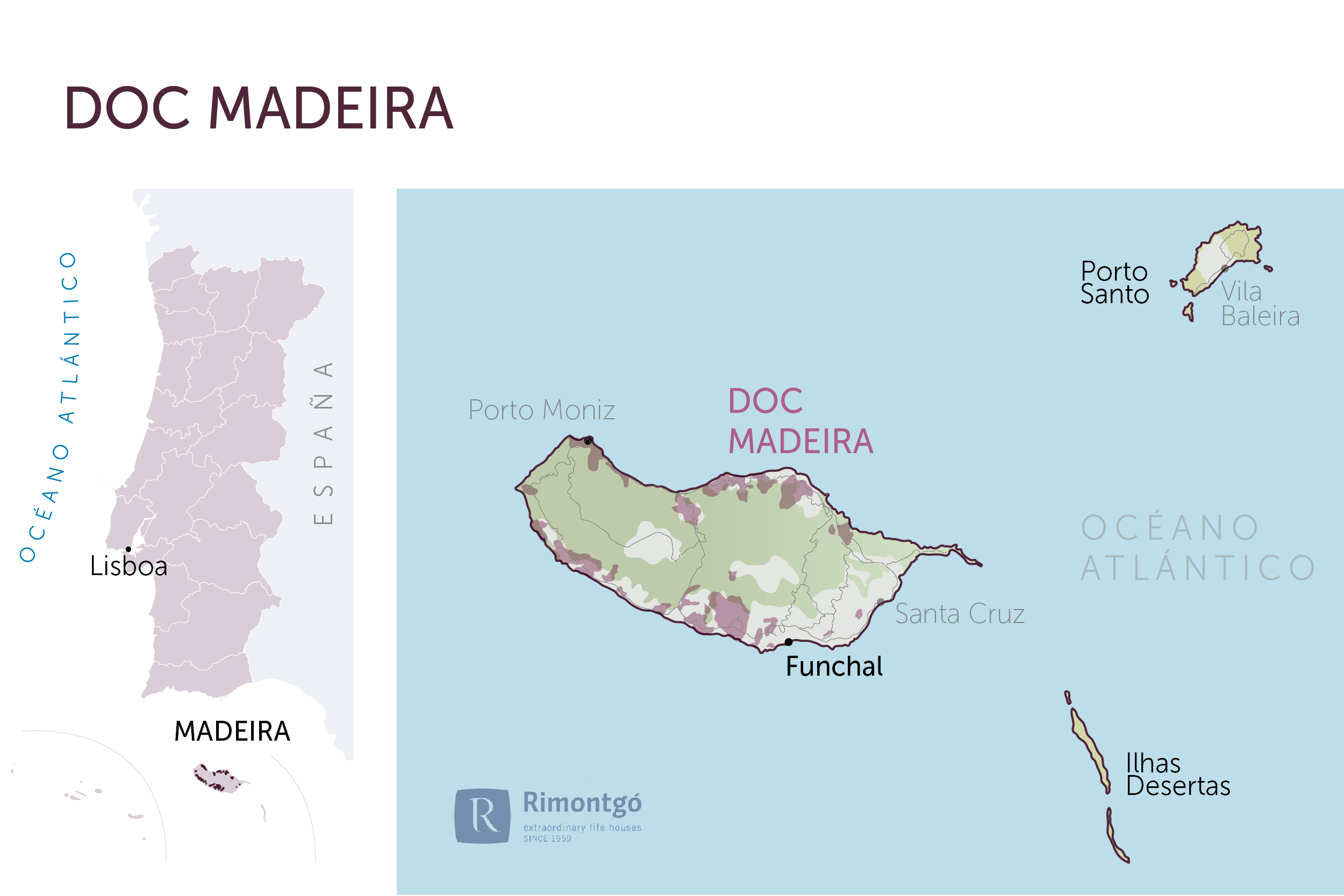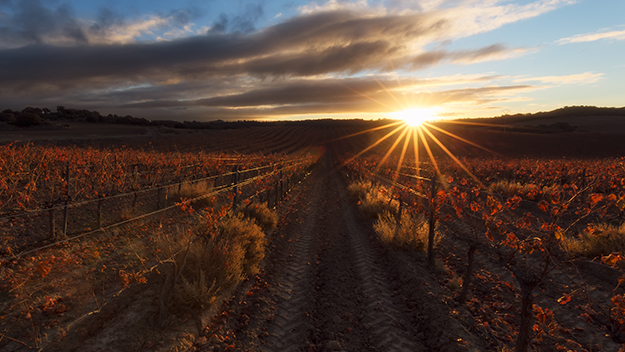Find your winery or vineyard
1 Wineries and Vineyards for sale in DOCs Madeira
Infographic of the Denomination of Origin

Change to imperial units (ft2, ac, °F)Change to international units (m2, h, °C)
DOCs Madeira
Wines
Classification by grape variety
Madeira fortified wine is a wine to which, during fermentation, wine alcohol is added resulting in a fortified wine that can contain a volume of alcohol ranging from 17% to 22%. After this process, the wines can be subjected to ‘Estufagem’ (controlled heating of the wine in an oven up to 50 ° C) or ‘Canteiro’ (placing the barrels on the highest floors of the cellar so that they have a natural heating and following a slow and controlled oxidation).these are the most common Madeira wine styles according to their varieties:
Sercial Madeira (Dry)
The Sercial grape is noted for its acidity and gives rise to dry Madeira wines with high acidity. They contain a minimum of residual sugar (9 to 27 g/l). They are delicate wines that work very well as aperitifs.
Madeira Verdelho (Semi-Dry)
These are wines with vibrant acidity. They tend to be more complex and full-bodied than the Sercial wines and have a residual sugar content ranging from 27 to 47 g/l. It is a very versatile wine, capable of enhancing the flavour of sweet and savoury dishes.
Madeira Boal (Semi-sweet)
Also known as bual, it is dark in colour. It is a sweet wine on the palate, but without being cloying and retains an acidity that balances its sweetness and, the older it gets, the more interesting and complex the wine becomes. It has a residual sugar content that can range from 45 to 63 g/l. A favourite wine for chocolate addicts, it is the perfect match for chocolates with 75% cocoa or more. Boal wines go well with patisserie. Most of these wines are made under the ‘canteiro’ process and you can find vintage bottles, which are known as ‘Colheita’.
Madeira Malvasia (Full Rich)
This is the wine, also known as Malmsey, for which Madeira is internationally known. It can be made from different varieties of Malvasia such as Cândida, Cândida Roxa and Malvasia de São Jorge, as long as they contain high levels of acidity. This wine is dark in colour. It is an ideal wine to accompany chocolate and dessert. It has a residual sugar content ranging from 63 to 117 g/l.
Madeira Terrantez (Semi-dry and semi-sweet)
There is a fifth noble variety, the white grape Terrantez, which was on the verge of extinction on the island but is currently being rescued and which produces wines in practically all ranges of sweetness, although never as dry as Sercial or as sweet as Malvasia.
Classification by sweetness level
In turn, the vines give rise to a style and dictate how long fermentation will take:
Full rich, the sweetest wine, is made from the Malvasia variety, whose must ferments for the shortest time. Sweet (Doce): wines containing more than 100 g/l of residual sugar.
Semi-sweet, made from the Boal grape variety. Medium Sweet (Meio Doce): wines with ~ 78-100 g/l of residual sugar.
Semi dry, produced from the Verdelho grape variety. Medium Dry (Meio Seco): wines having between ~ 54-78 g/l of residual sugar.
Dry, produced from Sercial, whose must ferments almost to the end. Dry: contain less than ~ 59 g/l of residual sugar and Extra Dry (Extra Seco): have less than 49 g/l. of residual sugar.
Classification according to ageing
Madeira wines made from at least 85% of the noble varieties are usually labelled according to their ageing time, with 5 years being the minimum allowed for each of these grapes.
Madeira wines have a number of styles determined by grape variety, type and ageing time. Their current classification is:
Selected: it is estufagem in inox and has an ageing of 3-5 years. It does not require strain specification.
Rainwater: It also performs estufagem and has an average ageing of 3 years up to a maximum of 10 years. Tinta negra mole, Verdelho or Sercial.
Its name comes from the myth that while the barrels were waiting to be picked up for their departure to America, as a result of the rain they swelled up on the beach and the merchants decided to sell the wine as a new, lighter style of Madeira. Later this wine was produced in vats on the beaches, the saltpetre and rainwater gave a salty aftertaste.
With age indication: a blend of different wines with different years of ageing. The only fixed requirement is that the years of ageing must be indicated. It can be a single-varietal or multi-varietal wine. There are 3, 5 (reserva), 10 (reserva velha), 15 (reserva extra), 20, 30, 40 years.
Reserva: Estufagem artificial as well, but with maturation between 5 and 10 years. However, it is not compulsory to include the grape variety and vintage.
Reserva Especial: Aged between 10 and 15 years. It is not compulsory to indicate the vine or vintage.
Reserva Extra (Extra Reserve): it is an uncommon style of wines with 15 years of ageing, as the producers prefer to extend the time to 20 years. The variety does not always appear, nor the vintage as the regulation is recent.
Reserve 20 years, 30 years, 40 years. The variety does not always appear, nor the vintage as the regulation is recent. This is the name given to Madeiras that have been aged between 20 and 30 years; between 30 and 40 years and between 40 and 50 years.
Solera: This type requires ageing in canteiro, so its price is higher. A system of refrescado is allowed (younger wine is added to replace that which is lost with the passage of time), with a maximum of 10 times and a maximum of 10% of the volume before bottling. Single-varietal wine aged for a minimum of 5 years before being transferred to the crianza and solera system, the year of harvest must be indicated.
Colheita: wine with particular characteristics, with indication of year, a single vine with a minimum ageing of 5 years, although it is not compulsory to be in canteiro and a maximum of 20 years. Afterwards it can remain much longer in the bottle.
Frasqueira/Garrafeira: wine with exceptional organoleptic characteristics, with indication of year, from a single vine, with a minimum ageing of 20 years in barrels. It is similar to the previous one, except that it must be aged in wooden casks for at least 20 years. All of them come from canteiros, which guarantees a great quality and a great price. Great Madeira wines that are practically for collectors.
Vino da Rado, Vinho da Volta, Vinho da Torno or Torna Viagem, all names that speak of this old classification that referred to wines that had passed the equator or gone around the world in a ship as it was done in the 15th or 16th centuries. Some of these bottles supposedly exist.
Discover more wineries and vineyards for sale in these wine regions in Islands
Subscribe to our mailing list to receive news about wineries and vineyards.








